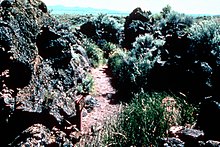Modoc War
The remaining 153 Modoc of the band were sent to Indian Territory (pre-statehood Oklahoma), where they were held as prisoners of war until 1909, settled on reservation land with the Shawnee.
The first known explorers from the United States to go through the Modoc country were John Charles Frémont together with Kit Carson and Billy Chinook in 1843.
On the night of May 9, 1846, Frémont received a message brought to him by Lieutenant Archibald Gillespie, from President James Polk about the possibility of war with Mexico.
[6] Accounts by scholars vary, but they agree that the attack completely destroyed the village structures; Sides reports the expedition killed women and children as well as warriors.
[8] Although most of the "49ers" missed the Modoc country, in March 1851 Abraham Thompson, a mule train packer, discovered gold near Yreka while traveling along the Siskiyou Trail from southern Oregon.
By April 1851, 2,000 miners had arrived in "Thompson's Dry Diggings" through the southern route of the old Emigrant Trail to test their luck, which took them straight through Modoc territory.
[10][12] In another round of retaliation, California militia led by an Indian fighter named Ben Wright killed 41 Modoc at a peace parley.
While the old Modoc chief remained in the reservation, Kintpuash returned to Lost River and led an abusive harassment against the white settlers who had occupied the area.
After a few attempts to negotiate in behalf of the complaining settlers, including failed attempts by Agent Lindsay Applegate in 1864–6[13] and Superintendent Huntington in 1867, the Modoc finally relocated in 1869 following a council between Kintpuash (also known as Captain Jack); Alfred B. Meacham, the US Superintendent of Indian Affairs for Oregon that replaced Huntington; O.C.
On April 3, 1872, Major Elmer Otis held a council with Captain Jack at Lost River Gap, near what is now Olene, Oregon.
[16] On April 12, the Commission of Indian Affairs directed US Superintendent T. B. Odeneal[15] to move Captain Jack and his Modoc to the reservation if practicable.
On July 6, 1872, the US Commissioner of Indian Affairs repeated his direction to Superintendent Odeneal to move Captain Jack and his band to the Klamath Reservation, peacefully if possible, but forcibly if necessary.
On November 27, Superintendent Odeneal requested Major John Green, commanding officer at Fort Klamath, to furnish sufficient troops to compel Captain Jack to move to the reservation.
Wishing to avoid conflict, Captain Jack agreed to go to the reservation, but the situation became tense when Jackson demanded that the Modoc chief surrender his weapons.
Suddenly an argument erupted between Modoc warrior Scarfaced Charley and Lieutenant Frazier A. Boutelle, of company B, 1st Cavalry.
A small band of Modoc under Hooker Jim retreated from the battlefield to the Lava Beds south of Tule Lake.
This version claimed that some warriors held their ground while the women and children loaded their boats and paddled south; that Scarfaced Charley, who spoke good English, was foul-tempered from lack of sleep, because he'd been gambling all night and was possibly drunk—but, since there was a warrant out for his arrest on a false murder charge, he wasn't going to go quietly.
For some months, Captain Jack had boasted that in the event of war, he and his band could successfully defend themselves in an area in the lava beds on the south shore of Tule Lake.
The Modoc took advantage of the lava ridges, cracks, depressions, and caves, all such natural features being ideal from the standpoint of defense.
The Peace Commission proposed: (1) That Captain Jack and his band go to a reservation selected by the government; (2) That the Modoc guilty of killing the settlers be surrendered and tried for murder.
Accompanied by John Fairchild and Judge Rosborough, with Frank and Toby Riddle serving as interpreters, Meacham met Captain Jack at the peace tent; it was erected about one mile east of Gillem's Camp.
After some talk, during which it became evident that the Modoc were armed, General Canby informed Captain Jack that the commission could not meet his terms until orders came from Washington.
Meacham fell seriously wounded, but Toby Riddle saved his life and interrupted warriors intending to scalp him by yelling, "The soldiers are coming!"
On April 26, Captain Evan Thomas commanding five officers, sixty-six troops and fourteen Warm Spring Scouts left Gillem's camp on a reconnaissance of the lava beds to locate the Modoc.
General Davis prepared to execute Captain Jack and his leaders, but the War Department ordered the Modoc to be held for trial.
Captain Jack, Schonchin John, Black Jim, Boston Charley, Brancho (Barncho) and Slolux were tried by a military court for the murders of Canby and Thomas, and attacks on Meacham and others.
On September 10, President Ulysses S. Grant approved the death sentence for Captain Jack, Schonchin John, Black Jim and Boston Charley; Brancho and Slolux were committed to life imprisonment on Alcatraz.
The troops included U. S. Army infantry, cavalry, and howitzer units; Oregon and California volunteer companies, and some Klamath Indian Scouts.
The Thomas-Wright battlefield, near Hardin Butte, is a feature of the monument; as is the site of Gillem's camp, the former military cemetery, Hospital Rock, and Canby's Cross.
Some of the same troops whom Canby had commanded at the Lava Beds were fighting other Indian Wars, and public interest ran high.








